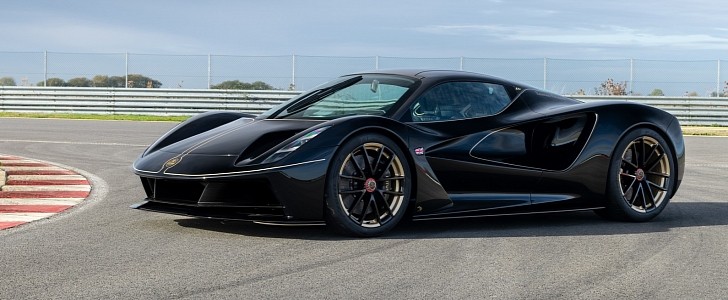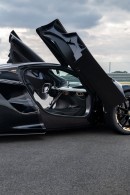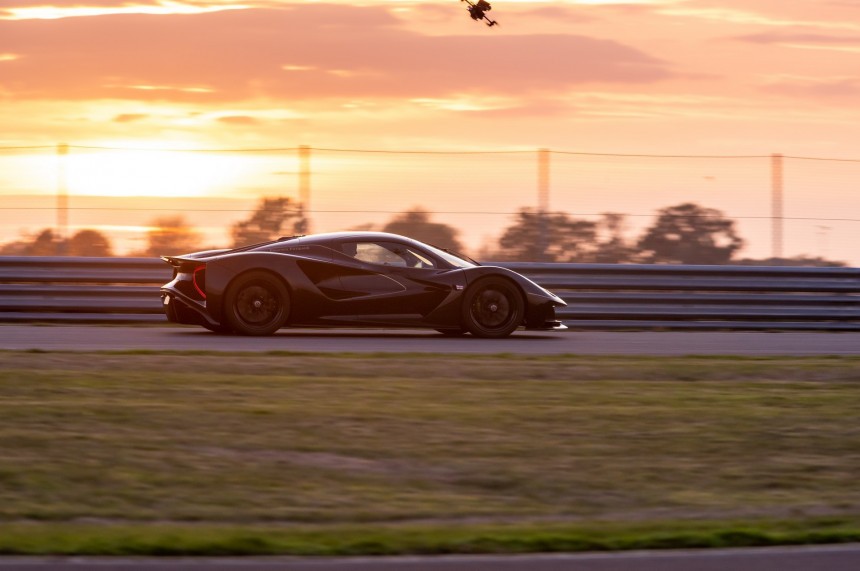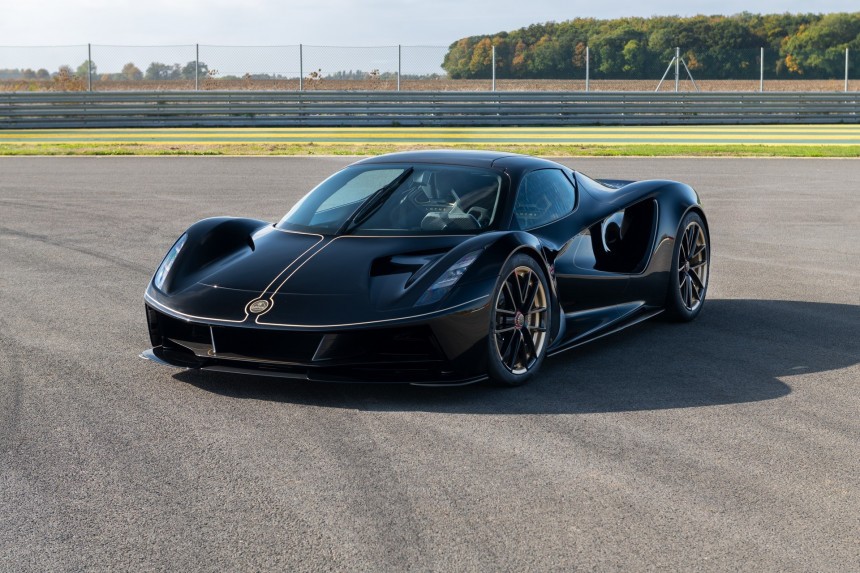Half a century ago, Lotus took Formula One by storm with a new aerodynamic design that changed motorsport forever and for the better. To celebrate the unrivaled performance from 1972, the British car manufacturer launched the most powerful production car in the world. The Elija Fittipaldi celebrates performance and motorsport heritage with milestone-setting specs.
The Lotus Evija Fittipaldi is a 1,500-kW (2,011 bhp / 2,039 PS) lightning storm with an all-electric quad-motor all-wheel-drive train that darts the car from zero to 186 mph (300 kph) in under nine seconds. Zero-to-sixty times should be equally impressive, with a score of under three seconds, according to the company, which avoided revealing the exact 0-60 mph (96 kph) figures. The top speed value is just as staggering (and electronically limited!): 217 mph (350 kph).
The one-piece carbon fiber monocoque chassis – a premiere for road cars wearing the British brand badge – keeps weight in check, with 4,160 lb (1,887 kg). A 1,257 lb-ft (1,704 Nm) torque is vectored for ultimate performance, and the 93-kWh battery pack gives the supercar a range of 250 miles (402 km). It takes only eighteen minutes for the battery to charge on a 350kWh charging station.
As a tribute to its forerunner’s aerodynamic performance, the limited-edition Evija features fluid lines along the profile. Just 44.3 inches tall, this Lotus rarity splits through the air like a blade. In line with this wind-slicing creed, the Evija gains downforce and loses air drag with the help of twin rear-quarter Venturi tunnels. This way, air flows over, under, around, and through the car.
A Formula One-inspired DRS (Drag Reduction System) tops the drag-minimizing abilities of the Lotus Evija, and the active rear wing (bearing the decals of the five F1 wins from 1972) keeps the car on track with mathematical precision.
Out of a total of 130, just eight Evijas (all already booked) will emerge from the assembly line during the first production run, which is underway in England. The number is not random, as it stands for the batch of surviving Lotus Type 72 Formula One racers. All the original 1972 Lotus F1 cars gathered at the launching event of the Evija, a vehicle that pays homage to the engineering prowess of half a century ago and to the man behind Lotus’ unparalleled success – Emerson Fittipaldi.
With five wins in eleven races, the car bestowed its pilot the 1972 Formula One title – at the time, the youngest driver to be crowned, at 25 (Emerson held that record for 33 years). Coincidentally, eight is the number that Fittipaldi raced with during his first World Championship title five decades ago. That is another reason why the number sits on the B-pillar of the black-and-gold painted Evija. The livery stands as yet another reminder of the Type 72 Formula One champion car (check the gallery to see the original garment of Emerson’s 1972 racecar and the contemporary body scheme on the Evija).
The awe-casting 2022 Lotus Evija is hand-built, hand-painted, and hand-tinted with a silhouette (seen from above) of the original Type 72 imprinted into the exposed carbon fiber roof. Together with Fittipaldi’s signature - hand-stitched into the dashboard – and the rotary dial on the floating central instrument panel (hand-crafted from a piece of the F1 car driven by Emerson), the Evija is a tribute worthy of a legend.
Emerson Fittipaldi introduced the electric Evija to its future owners after taking it for a spin around the circuit: “I’ve really enjoyed being a part of this project, and it’s been a wonderful experience revealing the car to some of the new owners. Having the opportunity to drive both the Evija Fittipaldi and my championship-winning Type 72 Formula 1 car on the test track at Hethel has been an incredible experience.”
And indeed, Formula One throwbacks are omnipresent throughout the Evija: an F1-inspired multifunctional steering wheel, center-locking wheels, and adjustable race-style seats, all bearing remembrance of the fantastic achievement of 1972.
“The word ‘legend’ is often overused, but this project has brought together the Lotus Evija hypercar, Emerson Fittipaldi, the Type 72 race car, and our brand’s celebrated Formula 1 heritage. No argument; that is four legitimate legends, all collaborating to deliver a truly unique hypercar and a world premiere that was a real ‘pinch yourself’ moment.” Simon Lane, Director, Lotus Advanced Performance
The one-piece carbon fiber monocoque chassis – a premiere for road cars wearing the British brand badge – keeps weight in check, with 4,160 lb (1,887 kg). A 1,257 lb-ft (1,704 Nm) torque is vectored for ultimate performance, and the 93-kWh battery pack gives the supercar a range of 250 miles (402 km). It takes only eighteen minutes for the battery to charge on a 350kWh charging station.
As a tribute to its forerunner’s aerodynamic performance, the limited-edition Evija features fluid lines along the profile. Just 44.3 inches tall, this Lotus rarity splits through the air like a blade. In line with this wind-slicing creed, the Evija gains downforce and loses air drag with the help of twin rear-quarter Venturi tunnels. This way, air flows over, under, around, and through the car.
A Formula One-inspired DRS (Drag Reduction System) tops the drag-minimizing abilities of the Lotus Evija, and the active rear wing (bearing the decals of the five F1 wins from 1972) keeps the car on track with mathematical precision.
With five wins in eleven races, the car bestowed its pilot the 1972 Formula One title – at the time, the youngest driver to be crowned, at 25 (Emerson held that record for 33 years). Coincidentally, eight is the number that Fittipaldi raced with during his first World Championship title five decades ago. That is another reason why the number sits on the B-pillar of the black-and-gold painted Evija. The livery stands as yet another reminder of the Type 72 Formula One champion car (check the gallery to see the original garment of Emerson’s 1972 racecar and the contemporary body scheme on the Evija).
The awe-casting 2022 Lotus Evija is hand-built, hand-painted, and hand-tinted with a silhouette (seen from above) of the original Type 72 imprinted into the exposed carbon fiber roof. Together with Fittipaldi’s signature - hand-stitched into the dashboard – and the rotary dial on the floating central instrument panel (hand-crafted from a piece of the F1 car driven by Emerson), the Evija is a tribute worthy of a legend.
Emerson Fittipaldi introduced the electric Evija to its future owners after taking it for a spin around the circuit: “I’ve really enjoyed being a part of this project, and it’s been a wonderful experience revealing the car to some of the new owners. Having the opportunity to drive both the Evija Fittipaldi and my championship-winning Type 72 Formula 1 car on the test track at Hethel has been an incredible experience.”
“The word ‘legend’ is often overused, but this project has brought together the Lotus Evija hypercar, Emerson Fittipaldi, the Type 72 race car, and our brand’s celebrated Formula 1 heritage. No argument; that is four legitimate legends, all collaborating to deliver a truly unique hypercar and a world premiere that was a real ‘pinch yourself’ moment.” Simon Lane, Director, Lotus Advanced Performance
























